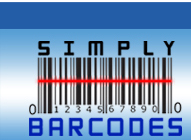UPC Code
What is a UPC Code?
|
"UPC" stands for Universal Product Codes.
UPC bar codes appear as lines (bars) of varying widths representing the series of numbers commonly shown below the bars. This series of numbers is known as the UPC number. The UPC code contains no other information than this UPC number. In short, the UPC bar code is a 12-digit unique code for your product represented by scannable bars in a way that a bar code scanner can read.
Bar code scanners, as you will know them from your favorite retailers, read the bars and convert them back to the 12-digit UPC number that they represent. This number is then looked up within the retailer's inventory system to find the corresponding product name and price that you provided this retailer with when you signed your agreements for them to carry your product. This information is sent back to the register and it rings up the item. If the bar code did not scan properly then the cashier simply enters the UPC number (from below the bars) manually into the register.
The standards as they relate to UPCs are managed by an organization called GS1. GS1 is the new name for EAN International and the UCC (Uniform Code Council). UPC codes can be obtained in two ways: 1) They are can be leased directly from GS1 for a considerable initial fee plus ongoing annual fees or 2) purchased for a one-time fee from a company like Simply Barcodes.
In the past, UPC bar codes consisted of a number system character, a manufacturer's number, a product number, and a check digit. The first six digits of a UPC bar code were referred to as the manufacturing number that always remained constant on all of a company's products. The manufacturing number was followed by a five digit product number that is unique to each product. The 12th digit was a mathematically calculated digit, called a check digit.
That system in its original form was abandoned some time ago. Currently, it is no longer possible to look at any given UPC and determine which portion of the 12 digit number is a fixed manufacturer's number and which portion is a product number. Why is this?
- The first reason is variable length prefixing. GS1 changed its business model and began issuing 7-digit, 8-digit, and even 9-digit manufacturer's prefixes in addition to the original 6-digit manufacturer's number. The result of this, however, is that it is no longer possible to look at any given UPC code and break it up into a manufacturer's prefix and product ID number.
- The second reason is that GS1 even leased single UPC numbers for a short time in 2008 - a program they've since discontinued in the U.S. but still offer in other GS1 member country organizations. Since these single UPC codes do not technically have a prefix, today, Universal Product Codes need to be taken as the whole unique 12-digit number which is then associated with your product/company information.
The last digit in the UPC bar code is still known as the check digit. This digit is mathematically calculated with a five-part equation based on the first 11 digits. Please see our check digit page if you are curious how this is done.
To request more information regarding Universal Product Codes (UPC) Bar Codes, please call on 1-877-872-2060 (toll-free) or 1-404-885-6066.
|
|
|



